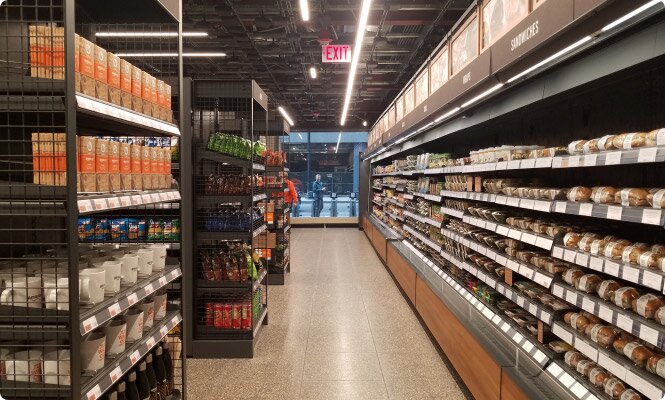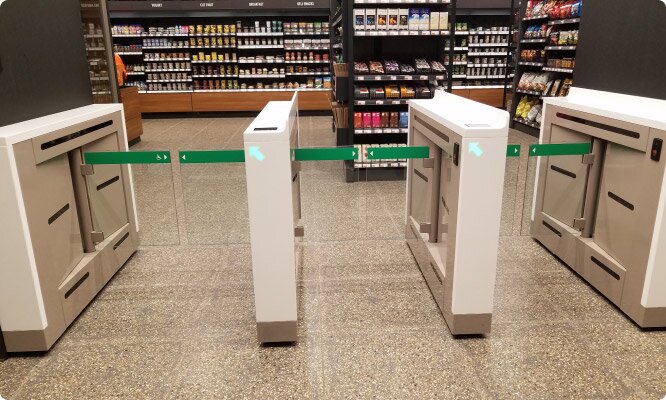High-Tech Software House
(5.0)

Who has never stood in a long queue to pay for groceries? We sure did! And we think that we can all agree that it can be more than annoying. Even with the implementation of autonomous cash registers in many stores, the shopping experience very often stays just as unpleasant as with regular checkout. The self-checkout registers tend to malfunction, and the clients very often don’t know how to use them proficiently. That often results in queues as long as the ones to a regular register. We all know that innovation comes from the need to improve our everyday lives. So, we thought at Flyps, how could we possibly make shopping at physical stores better?

The first idea of a cashierless store, also known as a checkout-free store, autonomous store, “Just walk out” store or till-less store, appeared in 2016, when Amazon announced the creation of Amazon Go, the first completely autonomous store, offering one of a kind, quick and futuristic shopping experience. It operated (and still operates) in a way so far only seen in science fiction movies. Just scan an app to enter, pick up whatever you’d like, leave the store and let the technology take care of the rest. Sounds simple, doesn’t it? Well, if you know anything about computer vision and deep learning, you’ll know it’s anything but simple.
Amazon Go is a chain of cashierless stores present in the United Kingdom and United States. There were 29 separate Amazon Go locations opened in 2020, including places like Seattle, Chicago, London, New York and San Francisco. The technologies that are used in the Amazon Go system include advanced software such as computer vision, deep learning algorithms and sensor fusion. The process of purchasing the goods, checkout and payment is fully automated. The revolutionary concept relies on smartphones and geofencing to streamline the customer's experience. The same technologies help with inventory management and supply chain. The deployment of the first store was met with various challenges. For example the sensors had troubles tracking multiple objects or users at once*. Unruly children moving the items from one place on the shelves to another also proved problematic. To understand the challenges that Amazon Go had to overcome, we have to understand the way it utilizes computer vision in conjunction with deep learning, by analyzing the body habitus of each user. Body habitus is the medical term for physique, and the way we move. Once we know that, we can easily come to the conclusion that the software might have had issues with differentiating users who looked and moved in a similar way*. Luckily, with some tweaks and changes in the algorithms, the store launched to great fanfare and excitement from the citizens of Seattle, where the first ever autonomous store of Amazon Go was deployed.

Inspired by the novel idea of Amazon Go we proposed to create brand new software that would operate on a similar premise, although in a novel way. After all, we didn’t just want to copy what Amazon did, we wanted to create our own thing and make it better than its predecessor. As such, we basically had to start everything from scratch. There were no out-of-the-box solutions that would just be ready for production. The amount of aspects that needed to be addressed might be seen by some as staggering, but for us it was nothing more than an exciting challenge.
ESL, also known as Electronic Shelf Labels, are a fairly old technology that just begins getting traction, that replaces the old, traditional, paper labels, with electronic labels, utilizing new and fresh technologies such as an e-paper display, wireless radio communication and geo-location, among others. With the use of ESL we integrated the central server data with the displayed labels, making it possible for the prices to be updated immediately without the need of printing, writing or changing the labels by hand. We also formed the first pillar of some crucial aspects of a cashierless store, like people counters and electronic article surveillance. Stylish and minimalistic look aside, ESLs not only make operating basically any store much easier and intuitive, but in our case, they allow us to fulfill some of the core principles of a cashierless store project like Take&GO. We suggested to order almost a thousand ESLs and integrated them in-house with Odoo CRM system.

One of the biggest similarities between Amazon Go and Take&GO, is the use of QR codes to count clients that enter the store. With the use of a dedicated app designed to scan the store’s QR code, we can begin tracking the users number inside, making sure that whatever product they put into their basket, is counted into their receipt properly. Naturally, as every other aspect of development, this too caused us some troubles. For example, what to do if someone would like to leave the store, but didn’t scan the QR code at the entrance? One of the solutions would be to install automatic gates that open only after the QR code is scanned and registered. This way, the possibility of having someone inside the store, who didn’t scan the app to enter it is lessened. Imagine it in a similar way as you would automated gates at a subway station. Even if you’re entering with a group of friends, everyone needs to scan their own ticket, as the gate opens only long enough for one person to pass. Similarly to subway stations, it would also be almost necessary to have a human employee, somewhere nearby, in case the machine gets a little confused and encounters an error we didn’t count into the development process.
How do you enter an autonomous store? Well, using a gate and a QR code of course! As we mentioned above, gates to autonomous stores are similar to the gates on a subway station, both from a mechanical and software point of view. Some of the subway gates are even already working with QR codes, as there are more and more options available that let you buy your tickets through mobile apps. Using QR code based gates not only makes customer counting easier, it also controls who and when enters the store, and it all happens in a way that’s simple and intuitive, and thanks to the implementation of similar technologies in public transport, customers already know how to operate a gate like that and are familiar with the concept. When designing a gate like that, we need to put extra care into making sure that none gets stuck inside the store and can’t leave. Ideally, we want the gates to work perfectly, without the need for human supervision. But what happens if the power goes out? Things like that happen. It might be because of a violent storm, some human error on the side of the power station, accidental cutting of the wires because of renovations going on nearby, and who knows what else. Point is, we needed to be prepared for a power outage, and we had to figure out a way for the customers to leave the store in a situation like that.. Sometimes, the simplest solutions are the best ones, so we used certified gates equipped with an emergency system, allowing them to open, and stay open, in case of a power outage. This way we don’t have to worry about customers being locked in a store, not only for the sake of their comfort and convenience, but also in many cases for their own safety.

Those are only a few of the challenges we encountered in the process of developing Take&GO. The story of this project is much longer and much more complicated, and we would love to share its entirety with you. But we know that overly lengthy articles can be taxing and even boring, so we decided to divide our journey through this amazing project into parts. We hope to see you in the next part of our article, in which we’ll be further discussing the hardware oriented obstacles we had to face when creating our autonomous store, but we’ll also introduce you to the app we’re using to let our customers enjoy the store in full. Make sure to write to us, if you’re interested in the topic and would like to learn more, or if you have experience with autonomous stores and would like to share some stories with us. Stay tuned for more!
See our tech insights
Like our satisfied customers from many industries